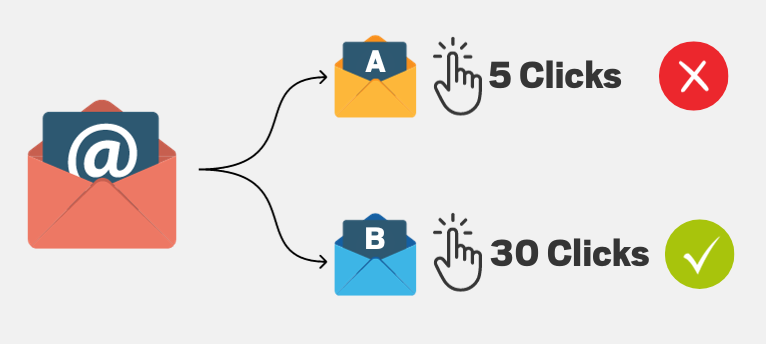In science marketing, email remains one of the most effective tools to deliver the right content to your leads and customers at the right time. In fact, a recent survey by Litmus found email marketing ROI to be an impressive $36 per every dollar spent. Projections of email marketing revenue worldwide are expected to reach $15.8 billion by 2026. Not surprisingly, our own C&EN Buying Power Survey found respondents who work in Biotech/Pharma/CRO rely on email as their top resource to keep abreast of products and technologies. Respondents in the Government work sector said they use email as their top resource when evaluating potential supplies for a particular product of interest.
These stats show that the revenue generating potential of email is undeniable. However, with increasingly crowded inboxes it’s important to utilize email marketing tips that optimize delivery and engagement with your target audience. Here, we dive into some best practices and provide guidance on how you can meet and exceed industry benchmarks for open rates, click-through, and bounce rates. Beyond getting the first opens and clicks, we’ll also discuss how to cultivate and re-engage leads by continuing to add value over time through email nurturing.
Understanding Email Marketing Benchmarks and Setting Goals
An important way to measure your success with email marketing is to understand industry benchmarks and how you can match, if not surpass, those standards. The inbound marketing experts at HubSpot keep an updated list of email open, click-through rates and other benchmarks across various industries. However, there are a few things you should consider when analyzing open rates. Apple’s Mail Privacy Protection (MPP) feature, which pre-loads emails on its own proxy, can inaccurately inflate this number and significantly throw your data off. Also, while open rates vary by industry, past studies have shown that B2B marketing rates tend to trend lower than B2C rates. Because of these circumstances, click rates tend to be a much more reliable and valuable data point for science marketers.

Every good email marketing strategy starts with a goal. Before creating content, think about what you want to accomplish. For example, you may want to reach an average email click through rate of X%. Or you may want to generate X number of leads per email campaign. You can use industry benchmarks to guide your goals, but remember that every audience is different. Don’t create unattainable goals. Start with small increases and keep bumping it up each quarter or year as your business progresses.
Creating Email Content That Grabs Attention and Initiates Action
So how can you craft an email that is going to draw the attention of the recipient and get you results that meet or exceed those benchmarks?
Here are best practices for optimizing your email content:
1. Craft a Compelling Email Subject Line
Of the emails that are opened, 33% of recipients indicate that they open it based on subject line alone. A few good tips tips for effective email subject lines include:
- Avoid words and elements known to be spam triggers such as $$$ or all caps.
- Keep it short and to the point to avoid getting clipped by email clients,
- Make your subject line about the recipient rather than the product or service you are promoting.
2. Have a Clear Call to Action (CTA)
Chances are you want your reader to do more than just open your email. If someone is hooked by your subject line, make sure your CTA is clear and follows suit. Avoid having too many CTAs that can confuse or distract your audience. There should be a primary next action that you want your audience to take after opening the email and it should lead seamlessly into a landing page or next desired step.
3. Give Before You Take
Finally, you should strive to give before you take, meaning offer something meaningful before asking the recipient to provide valuable information to you. Examples include a free trail, ebook, webinar, or white paper.
Automation Tools and A/B Testing Tips
So you’ve created the perfect email content! Now the next step is to deliver that content in the most effective and efficient way. Automation tools help with this by enabling a streamlined workflow in which a series of automated actions can be triggered based on a person’s behaviors or attributes, for example visiting a specific webpage while being in the “qualified lead” stage of your funnel. Automation not only contextualizes internal communication, it also helps align marketing and sales – making follow up tasks easier and ensuring content is delivered to leads and customers at the right time. Some of the best tools used by our industry for email marketing automation are Oracle Eloqua, Salesforce Pardot, HubSpot, Constant Contact, Mailchimp, and ActiveCampaign, amongst others.
As you build out your automated email marketing platform, it’s important to include A/B testing. One common mistake is to get carried away with A/B testing. Be sure to pick only one variable to test at a time so that you can accurately evaluate how effective that change was. Similarly, go into the testing with a clear goal in mind before you run the test in order to determine what success looks like. Some simple A/B tests might be to change the banner image at the top of the email, swap a word in the email subject line, or move the CTA button to a different location.

Segmentation and Audience Targeting Tips
To maximize the efficacy of email automation, conscious segmentation and audience targeting should be utilized. By segmenting your target audience, you create a more personalized experience for each contact and make them feel as if your email is just for them, rather than feel like another number on a mass-marketing list. Consider segmentation in broad strokes through audience personas, industry/market segment, or application area to create meaningfully contextualized messaging without needing to create dozens of email variations.
Be sure to use segmentation to maintain a healthy email list as well by actively reviewing your contacts and removing those that are no longer engaging. For example, think about culling your email list based on people who have not opened the past 5 emails from you, or 10, or more! Lastly, it’s important to make sure your lists are compliant with applicable email marketing regulations. Rules are always changing so be sure you stay up to date with the latest.
Cultivating and Re-engaging Leads
You’ve taken all the steps and delivered a successful email marketing campaign – now, how do you cultivate and nurture those leads to continue engagement? Cultivating your leads requires being consistent with your contacts to build that relationship and move them down the sales funnel. Use lead nurturing tactics by continuing to provide value in the form of resources, discounts, helpful nudges – remember that “give before you take” idea? Even with the best lead nurturing strategies, there will always be those leads that stop interacting and need reengaging.
Here are 3 steps to reengage inactive leads with email:
- Step 1: Identify Inactives. Use your email marketing platform to identify members on your email list who have not clicked on or engaged with your emails for a defined length of time.
- Step 2: Use a Re-engagement Strategy. Consider creating a “we miss you” email with a special incentive or a survey to understand why they became inactive. You could offer a discount or giveaway, remind them why they signed up or engaged the first time, or show subscribers some of the latest content they missed.
- Step 3: Add Value. Once you recapture leads, pay careful attention to the content they receive from you next to ensure it addresses any identified issues and provides value.
Always follow up – with everyone’s crowded inboxes, that first re-engagement email can go unnoticed. Don’t be afraid to send it again. For more tips on reengement campaigns, visit our blog post: How to Re-Engage Inactive Leads with Email
Email marketing should be a central tool in every science marketer’s kit, and with these tips and tricks, we hope you’re able to craft messages that deliver value and drive engagement. For more tips like this, be sure to subscribe to our monthly newsletter.


















